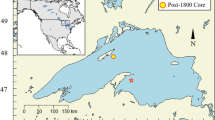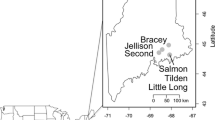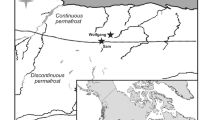Abstract
Understanding and managing the responses of natural systems to climate change requires knowing whether recent changes in ecosystem structure and function are within the bounds of natural variation or whether the systems are entering new states that are unprecedented. Several recent studies of the fossil diatom record of the last ~ 150 years in Andean lakes have shown changes in diatom species composition that suggest changes in lake thermal structure in response to regional climate warming. Yet these paleolimnological records are only a few hundred years in length, so it is unclear whether the systems have entered new states, with potentially severe consequences for ecosystem structure and function, or whether current trends are within the natural variability of the systems. Here, we use a recently compiled diatom database from tropical South America to explore the regional distribution and ecological controls of selected planktic diatom taxa that are associated with warming and changes in the lake thermal structure. We also review published Andean stratigraphic records that span thousands of years to characterize the long-term dynamics of relevant planktic species in response to past climate change. The contemporary data show that many planktic taxa have broad latitudinal and elevational distributions. The distributions of several taxa are correlated with surface water temperature, but most also are correlated with pH and/or conductivity. A review of existing stratigraphic data from Andean lakes demonstrates that rapid changes in diatom abundance, including abrupt increases followed by decades to centuries of near extirpation, are a common mode of population variation for some planktic taxa. Yet the majority of these published paleolimnological investigations are of lakes that are larger and differ in nutrient status and conductivity from the small dilute systems where recent species shifts have been observed. We propose that assessing the resilience of contemporary diatom communities and, by inference, lake ecosystems is best done by generating new records from Andean lakes of varied size and chemistry that span a millennium or more and hence a broader spectrum of climate conditions, coupled with new ecological and biogeographic studies that build upon ongoing research programs in the tropical Andes.




Similar content being viewed by others
References
Aguilera X, Declerck S, De Meester L, Maldonado M, Ollevier F (2006) Tropical high Andes lakes: a limnological survey and an assessment of exotic rainbow trout (Oncorhynchus mykiss). Limnologica 36:258–268
Baker PA, Fritz SC (2015) Nature and causes of Quaternary climate variation of tropical South America. Quat Sci Rev 124:31–47
Bao R, Hernandez A, Sáez A, Giralt S, Prego R, Pueyo JJ, Moreno A, Valero-Garcés BL (2015) Climatic and lacustrine morphometric controls of diatom paleoproductivity in a tropical Andean lake. Quat Sci Rev 129:96–110
Barta B, Mouillet C, Espinosa R, Andino P, Jacobsen D, Christoffersen KS (2017) Glacial-fed and páramo lake ecosystems in the tropical high Andes. Hydrobiologia 813:19–32
Benito X, Fritz SC, Steinitz-Kannan M, Tapia P, Kelly M, Lowell T (2018a) Geo-climatic factors drive diatom community distribution in tropical South American freshwaters. J Ecol 106:1660–1672
Benito X, Fritz SC, Steinitz-Kannan M, Veliz M, McGlue M (2018b) Lake regionalization and diatom metacommunity structuring in tropical South America. Ecol Evol. https://doi.org/10.1002/ece3.4305
Bush MB, Correa-Metrio A, McMichael CH, Sully S, Shadik CR, Valencia BG, Guilderson T, Steinitz-Kannan M, Overpeck JT (2016) A 6900-year history of landscape modification by humans in lowland Amazonia. Quat Sci Rev 141:52–64
Camburn KE, Charles DF (2000) Diatoms of low alkalinity lakes and streams in the Northeastern United States. The Academy of Natural Sciences of Philadelphia Special Publication 18, Philadelphia
Casimiro WSL, Labat D, Ronchail J, Espinoza JC, Guyot J-L (2012) Trends in rainfall and temperature in the Peruvian Amazon-Andes basin over the last 40 years (1965–2007). Hydrol Process 25:3721–3734
Ekdahl E, Fritz SC, Baker PA, Rigsby CA, Coley K (2008) Holocene multi-decadal to millennial-scale hydrologic variability on the South American Altiplano. Holocene 18:867–876
Fritz SC (2008) Deciphering climatic history from lake sediments. J Paleolimnol 39:5–16
Fritz SC, Baker PA, Lowenstein TK, Seltzer GO, Rigsby CA, Dwyer GS, Tapia PM, Arnold KK, Ku T-L, Lou S (2004) Hydrologic variation during the last 170,000 years in the southern hemisphere tropics of South America. Quat Res 61:95–104
Fritz SC, Baker PA, Tapia P, Garland J (2006) Spatial and temporal variation in cores from Lake Titicaca, Bolivia/Peru during the last 13,000 years. Quat In 158:23–29
Fritz SC, Baker PA, Tapia PM, Spanbauer T, Westover KS (2012) Evolution of the Lake Titicaca basin and its diatom flora over the last ~ 370,000 years. Palaeogeogr Palaeoclim Palaeoecol 317–318:93–103
Giles MP, Michelutti N, Groomes C, Smol JP (2018) Long-term limnological changes in the Ecuadorian páramo: comparing the ecological responses to climate warming of shallow waterbodies versus deep lakes. Freshw Biol. https://doi.org/10.1111/fwb.13159
Guiry MD, Guiry GM (2017) AlgaeBase. World-wide electronic publication, National University of Ireland, Galway. http://www.algaebase.org. Accessed May 2017
Hallstan S, Trigal C, Johansson KSL, Johnson RK (2013) The impact of climate on the geographical distribution of phytoplankton species in boreal lakes. Oecologia 173:1625–1638
Hillyer R, Valencia B, Bush MB, Silman MR, Steinitz-Kannan M (2009) A 24,700 year paleolimnological history from the Peruvian Andes. Quat Res 71:71–82
Jampel C (2016) Cattle-based livelihoods, changes in the taskscape, and human-bear conflict in the Eucadorian Andes. Geoforum 69:84–93
Knudson R (1957) Ecology of the epiphytic diatom Tabellaria flocculosa (Roth) Kutz. var. flocculosa in three English lakes. J Ecol 45:93–112
Koppen JD (1975) A morphological and taxonomic consideration of Tabellaria (Bacillariophyceae) from the northcentral United States. J Phycol 11:236–244
Labaj AL, Michelutti N, Smol JP (2016) Changes in cladoceran assemblages from tropical high mountain lakes during periods of recent climate change. J Plankton Res. https://doi.org/10.1093/plankt/fbw092
Masson-Delmotte VM, Schulz M, et al (2013) Information from paleoclimate archives. In: Climate Change 2013: The Physical Science Basis. Contribution of Working Group 1 to the Fifth Assessment Report of the Intergovernmental Panel on Climate Change. Cambridge University Press, Cambridge
Matthews-Bird F, Brooks SJ, Holden PB, Montoya E, Gosling WD (2016) Inferring late-Holocene climate in the Ecuadorian Andes using a chironomid-based temperature inference model. Clim Past 12:1263–1280
Michelutti N, Cooke CA, Hobbs WO, Smol JP (2015a) Climate-driven changes in lakes from the Peruvian Andes. J Paleolimnol 54:153–160
Michelutti N, Wolfe AP, Cooke CA, Hobbs WO, Vuille M, Smol JP (2015b) Climate change forces new ecological states in tropical Andean lakes. PLoS ONE 10(2):30115338
Michelutti N, Labaj AL, Grooms C, Smol JP (2016a) Equatorial mountain lakes show extended periods of thermal stratification with recent climate change. J Limnol 75:403–408
Michelutti N, Lemmen JL, Cooke CA, Hobbs WO, Wolfe AP (2016b) Assessing the effects of climate and volcanism on diatom and chironomid assemblages in an Andean lake near Quito, Ecuador. J Limnol 75:275–286
Morueta-Holme N, Engemann K, Sandoval-Acuñ P, Jonas JD, Segnitz RM, Svenning J-C (2015) Strong upslope shifts in Chimborazo’s vegetation over two centuries since Humboldt. Proc Natl Acad Sci 112:12741–12745
Mosquera P, Hampel H, Vázquez RF, Alonso M, Catalan J (2017) Abundance and morphomentry changes across the high-mountain lake-size gradient in the tropical Andes of southern Ecuador. Wat Resour Res 53:7269–7280
Nottingham AT, Whitaker J, Turner BL, Salinas N, Zimmermann M, Malhi Y, Meier P (2016) Climate warming and soil carbon in tropical forests: insights from an elevation gradient in the Peruvian Andes. Biogeosciences 65:906–921
PAGES 2 K Consortium (2013) Continental-scale temperature variability during the past two millennia. Nat Geosci 6:339–346
Rabatel A, Francou BM, Soruco A, Gome J, Cáceres B (2013) Current state of glaciers in the tropical Andes: a multi-century perspective on glacier evolution and climate change. Cryosphere 7:81–102
Randsalu-Wendrup L, Conley DJ, Carstensen J, Fritz SC (2016) Paleolimnological records of regime shifts in lakes in response to climate change and anthropogenic activities. J Paleolimnol 56:1–14
Rehm EM, Feeley KJ (2013) Forest patches and the upward migration of timberline in the tropical Andes. For Ecol Manag 305:204–211
Riedinger MA (1993) The application of fossil diatom assemblages in reconstructing mid to late Holocene climate in the neotropics: The paleolimnology of Huarmicocha and lake Ayauchi, Ecuador. Ph.D. Dissertation, Ohio State University
Ruhland K, Paterson AM, Smol JP (2008) Hemispheric-scale patterns of climate-related shifts in planktonic diatoms from North American and European lakes. Glob Change Biol 14:2740–2745
Ruhland K, Paterson AM, Smol JP (2015) Lake diatom responses to warming: reviewing the evidence. J Paleolimn 54:1–35
Saros JE, Anderson NJ (2014) The ecology of the planktonic diatom Cyclotella and its implications for global environmental change. Biol Rev 90:522–547
Saros JE, Michel TJ, Interlandi SJ, Wolfe AP (2005) Resource requirements of Asterionella formosa and Fragilaria crotonenesis in oligotrophic alpine lakes: implications for recent phytoplankton community reorganizations. Can J Fish Aquat Sci 62:1681–1689
Spaulding SA, Out M, Wolfe AP, Baron J (2015) Paleolimnological records of nitrogen deposition in shallow, high-elevation lakes of Grand Teton National Park, Wyoming, USA. Arct Alpine Ant Res 47:701–715
Steffan W, Richardson K, Rockstrom J, Cornell SE, Fetzer I, Bennett EM, Biggs R, Carpenter SR, de Vries W, de Wit CA, Folke C, Gerten D, Heinke J, Mace GM, Persson LM, Ramanathan V, Reyers B, Sorlin S (2015) Planetary boundaries: guiding human development on a changing planet. Science 347:736
Steinitz-Kannan M, Nienaber MA, Riedinger MA, Kannan R (1993) The fossil diatoms of Lake Yambo, Ecuador. A possible record of El Nino events. Bull Inst fr études Andines 22:227–241
Sylvestre F, Servant M, Servant-Vildary S, Causse C, Fournier M, Ybert JP (1999) Lake-level chronology on the southern Bolivian Altiplano (18–23°S) during late-glacial time and the early Holocene. Quat Res 51:54–66
Tapia PM, Fritz SC, Baker PA, Seltzer GO, Dunbar RB (2003) A late Quaternary diatom record of tropical climate history from Lake Titicaca (Peru and Bolivia). Palaeogeogr Palaeoclim Palaeoecol 194:139–164
Tapia PM, Theriot EC, Fritz SC, Cruces F, Rivera P (2004) Distribution and morphometric analysis of Cyclostephanos andinae comb. nov. a planktonic diatom from the Central Andes. Diatom Res 19:311–327
Tapia P, Fritz SC, Seltzer GO, Rodbell D, Metivier S (2006) Contemporary distribution and late-Quaternary stratigraphy of diatoms in the Junin Plain, central Andes, Peru. Boletín de la Sociedad Geol del Perú 101:19–42
Van Colen WR, Mosquera P, Vanderstukken M, Goiris K, Carrasco M-C, Decaestecker E, Alonso M, León-Tamariz F, Muylaert K (2017) Limnology and trophic status of glacial lakes in the tropical Andes (Cajas National Park, Ecuador). Freshw Biol 62:458–473
Velez MI, Hooghiemstra H, Metcalfe S, Wille M, Berrío JC (2006) Late Glacial and Holocene environmental and climatic changes from a limnological transect through Colombia, northern South America. Palaeogeogr Palaeoclim Palaeoecol 234:81–96
Vuille M, Bradley R, Werne M, Keimig F (2003) 20th century climate change in the tropical Andes: observations and model results. Clim Change 59:75–99
Weide DM, Fritz SC, Hastorf CA, Bruno M, Baker PA, Guedron S, Salenbien W (2017) A ~ 6000-year diatom record of mid- to late-Holocene fluctuations in the level of Lago Wiñaymarca, Lake Titicaca, (Peru/Bolivia). Quat Res 88:179–182
Wood SN (2006) Generalized additive models: an introduction with R. Chapman and Hall/CRC, London
Acknowledgements
The writing of this manuscript was supported by a Tage Erlander Visiting Professorship to SF from the Swedish Research Council, as well as NSF EAR-1338694 and National Geographic #8672-09 Grants. XB was supported in the revision of the manuscript by the National Socio-Environmental Synthesis Center (SESYNC), under funding received from the NSF DBI-1639145. We gratefully acknowledge colleagues who submitted samples and published and unpublished diatom and environmental data for the construction of the database, including P. Tapia, M. Velez, M. McGlue, N. Michelutti, F. Mayle, W. Gosling, B. Valencia, and J. P. Bradbury.
Author information
Authors and Affiliations
Corresponding author
Rights and permissions
About this article
Cite this article
Fritz, S.C., Benito, X. & Steinitz-Kannan, M. Long-term and regional perspectives on recent change in lacustrine diatom communities in the tropical Andes. J Paleolimnol 61, 251–262 (2019). https://doi.org/10.1007/s10933-018-0056-6
Received:
Accepted:
Published:
Issue Date:
DOI: https://doi.org/10.1007/s10933-018-0056-6




